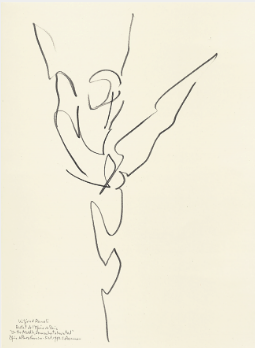


Stanley Roseman and the Dance - Drawings from the Paris Opéra presents 125 magnificent drawings from a Golden Age of Dance at the illustrious Paris Opéra. Created at a unique time in the history of the Paris Opéra, Roseman's drawings reproduced in the book span the years 1990 to 1996 - through the five seasons the Palais Garnier was dedicated exclusively to dance, with performances by the celebrated Paris Opéra Ballet and guest appearances by major international dance companies from Europe, Russia, Japan, and the United States. This beautiful fine art book includes Roseman's drawings from the first years the Paris Opéra Ballet performed at the new Opéra Bastille and - following a year and a half of refurbishing and renovation of the Palais Garnier - from the gala reopening of the world-famous opera house that crowns the grand Avenue de l'Opéra.
3. Opéra Bastille
4. Palais Garnier
5. Stanley Roseman drawing the dance from the wings of the stage of the Paris Opéra
"My interest in the dance is neither to illustrate the story of a ballet nor to depict dancers in repose or readying for a performance. For me the subject of the dance is the dancer dancing. Stimulated by the athleticism and sensuality of the dance, I am interested in the dancer's emotive use of movement as a means of personal expression."
"Stanley Roseman - Instinctive communion between us. The pencil seems alive, flying and moving around at lightning speed, impassioned actor-dancer in the shadow of the wings, witness of our fleeting emotions, he transfixes and transcends us with the fire of an immense talent.''
"Stanley Roseman's drawings show the many facets of his great talents as a draughtsman."
- Bibliothèque Nationale de France
Stanley Roseman and the Dance
Drawings from the Paris Opéra
Drawings from the Paris Opéra
At the Paris Opéra
In celebration of the reopening of the Paris Opéra, Palais Garnier, March 1996, the Bibliothèque Nationale de France presented at the Bibliothèque-Musée de l'Opéra, housed in the Palais Garnier, the exhibition Stanley Roseman - Dessins sur la Danse à l'Opéra de Paris.
6. Exhibition poster: Stanley Roseman - Dessins sur la Danse à l'Opéra de Paris presented by the Bibliothèque Nationale de France.
''magnificent drawings''
On Drawing and the Dance
A Passion for Drawing
"an extremely handsome presentation of Mr. Roseman's drawings of the Opéra dancers"
The international dance companies invited to perform on the famous stage of the Paris Opéra provided Roseman with continuing inspiration for his work. The artist had the wonderful opportunity to draw dancers of different nationalities in an exciting variety of styles of dance at memorable events.
8. Rudolf Nureyev, 1975
Martha Graham Dance Company
Lucifer
Pencil on paper, 35 x 27.5 cm
Israel Museum, Jerusalem
Martha Graham Dance Company
Lucifer
Pencil on paper, 35 x 27.5 cm
Israel Museum, Jerusalem
9. Mikhail Baryshnikov, 1975
American Ballet Theatre
Giselle
Pencil on paper, 35 x 27.5 cm
Albertina, Vienna
American Ballet Theatre
Giselle
Pencil on paper, 35 x 27.5 cm
Albertina, Vienna
''Drawing and dance seem to be naturally related systems of gesture, and in his introduction Mr. Roseman nicely describes the flow and gradations of touch which distinguish both systems of expression. The book is an extremely handsome presentation of Mr. Roseman's drawings of the Opéra dancers, and the exhibition that is commemorated by the poster must have been a special occasion.''
''drawings of great quality by Stanley Roseman''
- Monique Loudières
Star Dancer of the Paris Opéra
Star Dancer of the Paris Opéra

- Stanley Roseman
''You have presented the Cabinet of Prints and Drawings of the Museums of Strasbourg with an ensemble of five drawings of great quality by Stanley Roseman. . . . These remarkable portrayals of dancers of the Paris Opéra Ballet and of an actress drawn at the Ranelagh Theatre integrate quite naturally in the suite of our prestigious series of works by Bakst and Rodin and enrich in a wonderful way the collection of the Cabinet of Prints and Drawings.''
''astonishing spontaneity of action and of refinement''
11. Elisabeth Platel, 1996
Paris Opéra Ballet
Tchaikovsky Pas de Deux
Pencil on paper, 38 x 28 cm
Musée d'Art Moderne et Contemporain, Strasbourg
Paris Opéra Ballet
Tchaikovsky Pas de Deux
Pencil on paper, 38 x 28 cm
Musée d'Art Moderne et Contemporain, Strasbourg
12. Wilfried Romoli, 1993
Paris Opéra Ballet
In the Middle, Somewhat Elevated
Pencil on paper, 38 x 28 cm
Palais des Beaux-Arts, Lille
Paris Opéra Ballet
In the Middle, Somewhat Elevated
Pencil on paper, 38 x 28 cm
Palais des Beaux-Arts, Lille
Barbara Brejon de Lavergnée, Curator of the Cabinet of Prints and Drawings of the Lille Museum, writes warmly in letter of appreciation to Ronald Davis:
''The drawings that you so thoughtfully brought to us are superb. I love immensely the drawings of the dancers, which have an astonishing spontaneity of action and of refinement. The two chalk drawings are equally very beautiful. The clown and the portrait express feelings with much restraint.
''a very beautiful book''
''Dear Stanley,
Stanley Roseman and the Dance - Drawings from the Paris Opéra reached First Place on the Bestselling list at Barnes & Noble.com Books in three categories of hardcover books:
- Madeleine M. Nichols
Curator of the Dance Collection
New York Public Library for the Performing Arts
New York Public Library for the Performing Arts
From New York to Paris
- Anny-Claire Haus
Curator, Cabinet of Prints and Drawings
Museums of Strasbourg
Curator, Cabinet of Prints and Drawings
Museums of Strasbourg
- Rodolphe Rapetti
Curator of Patrimony and Director
Museums of Strasbourg
Curator of Patrimony and Director
Museums of Strasbourg
© Photo by Ronald Davis
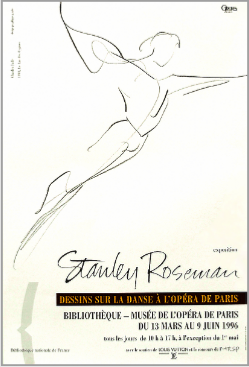
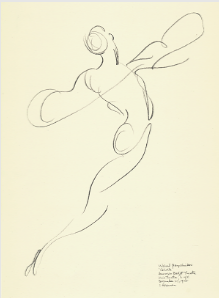
© Stanley Roseman

© Stanley Roseman
The acquisition for the Strasbourg Museum of Modern and Contemporary Art of the Roseman drawings of dancers of the Paris Opéra Ballet includes the artist's drawing of the Russian comedienne Elena Yaravaya in the farce Fata Morgana presented in Paris by the Derevo clown troupe from St. Petersburg. In the Introduction to his book of drawings on the dance, Roseman speaks of having dedicated an extensive series of drawings to the subject of the clown.
The book includes drawings from the Bolshoi Ballet, Stuttgart Ballet, Netherlands Dance Theatre, Béjart Ballet Lausanne, Wuppertal Dance Theatre, Marseilles Ballet-Roland Petit, Preljocaj Dance Company, Rosas, Twyla Tharp and Dancers, Alvin Ailey Dance Theatre, San Francisco Ballet, American Ballet Theatre, and the Martha Graham Dance Company.

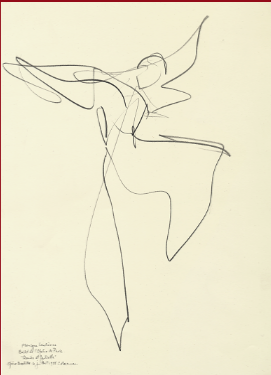
Monique Loudières, 1995
Paris Opéra Ballet
Romeo and Juliet
Pencil on paper, 38 x 28 cm
British Museum, London
Paris Opéra Ballet
Romeo and Juliet
Pencil on paper, 38 x 28 cm
British Museum, London
© Stanley Roseman
© Stanley Roseman and Ronald Davis - All Rights Reserved
Visual imagery and website content may not be reproduced in any form whatsoever.
Visual imagery and website content may not be reproduced in any form whatsoever.
Click here at barnesandnoble.com to order your copy of
Stanley Roseman and the Dance - Drawings from the Paris Opéra
Stanley Roseman and the Dance - Drawings from the Paris Opéra

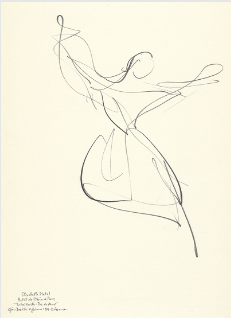
© Stanley Roseman
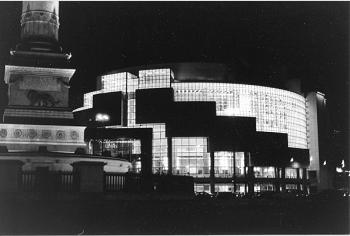
© Photo by Ronald Davis
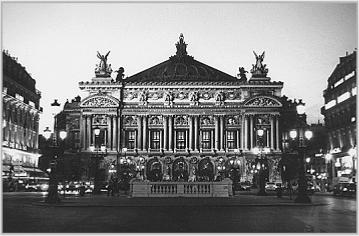
© Photo by Ronald Davis
The fine art book features Roseman's drawings of dancers of the celebrated Paris Opéra Ballet in an impressive range of Romantic and classical ballets, modern dance, Paris premieres, and world premieres.
''Avec ma très sincère admiration''
- Jean Favier
President
Bibliothèque Nationale de France
- Jean Favier
President
Bibliothèque Nationale de France
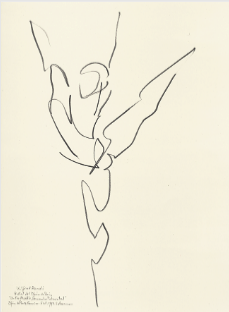
© Stanley Roseman
- Barbara Brejon de Lavergnée
Curator of the Cabinet of Prints and Drawings
Palais des Beaux-Arts, Lille
Curator of the Cabinet of Prints and Drawings
Palais des Beaux-Arts, Lille
- Bruno Hamard
Administrator of the Paris Opéra Ballet
Opéra de Paris Administrator of the Paris Opéra Ballet
The suite of Roseman drawings in the Lille Museum includes the exemplary sheet depicting Paris Opéra star dancer Wilfried Romoli, represented here, (fig. 12), and in the book, (Plate 89). Romoli is seen in the exciting, modern dance piece In the Middle, Somewhat Elevated, choreographed by William Forsythe for the Paris Opéra Ballet to Tom Willems' pulsating score for synthesizer.
The cordial invitation to Roseman from the Paris Opéra administration was reaffirmed by the dancers' esteem for his draughtsmanship and intuitive understanding of the dance. Roseman became " 'an honorary member' of the ballet troupe," notes the Bibliothèque Nationale de France in a biographical essay on the artist.
Roseman drew at rehearsals in the dance studios and at dress rehearsals in the auditorium, and he was given the extraordinary privilege to draw from the wings of the illustrious stage of the Paris Opéra during performances night after night. "Dressed in black to blend into the shadows, Stanley Roseman stands in the wings of the Paris Opéra, capturing the grace and virtuosity of France's top ballet dancers with a few masterful strokes of a pencil" (Associated Press, Paris).
The distinguished President of the Bibliothèque Nationale de France and Member of the French Institute, Jean Favier, opened the exhibition on the evening of March 12th. The first to sign the artist's guest book, Jean Favier writes:
The exhibition, sponsored by Louis Vuitton, ran for more than three months, surpassing its scheduled closing date.
Praising the artist for his "magnificent drawings," the Bibliothèque Nationale de France states that Roseman's oeuvre on the dance "gives an answer to the challenge of expressing movement in a single pictorial image" and affirms, "Stanley Roseman's drawings show the many facets of his great talents as a draughtsman."
Stanley Roseman and the Dance - Drawings from the Paris Opéra (ISBN: 2-9510196-0-2) published by Ronald Davis, 1996, is hardcover, 34 x 25 cm. (13 x 10 inches), 253 pages, and beautifully printed in duotone on 200 gm. satin paper. The book cover is in black linen with the title embossed in gold. The book jacket is printed on heavy-duty coated paper for long wear. The inside flaps contain information about the book and a brief biography on the artist. On the back of the book jacket are words of praise for Roseman's drawings from star dancers of the Paris Opéra. The book contains an acknowledgement; list of plates; and an appendix, which enumerates the ballets and provides pertinent information as to music, composer, and choreographer.
Roseman has written an absorbing introductory text entitled "On Drawing and the Dance'' in which he speaks intimately about his working methods, his thoughts on art, and his passion for drawing. The artist has devoted much of his professional career to drawing, considered the foundation of the visual arts. "As I embarked on my career," Roseman writes, "drawings became an increasingly important part of my work, not as studies or preparatory sketches for my paintings, engravings, or sculptures, but as works complete unto themselves.''
The artist recalls his early career in New York City, where he found inspiration in the exciting world of the performing arts. With invitations from leading opera, theatre, and dance companies, Roseman drew actors, singers, and dancers at rehearsals and performances. At the famous Ringling Bros. and Barnum & Bailey Circus, he began a work on the subject of the clown, which earned him an outstanding review in The New York Times and is a subject to which he enthusiastically returned in Paris. Roseman also speaks about his critically acclaimed works on the nomadic Saami people of Lappland and the monastic life - an ecumenical work brought to realization in the enlightenment of Vatican II and encompassing communities of Roman Catholic, Anglican, and Lutheran monks and nuns throughout Europe. The Bibliothèque National de France states in a biographical essay on the artist that Roseman "combines an innate artistic talent with a wide range of techniques, with a profound interest in the human condition in portraying different kinds of people, professions, social or artistic groups.''
From New York to Paris, the dance occupies an important place in Roseman's oeuvre. Stanley Roseman and the Dance - Drawings from the Paris Opéra features in the text full-page reproductions of two of Roseman's drawings from the mid-seventies in New York City. Rudolf Nureyev, 1975, reproduced below, (fig. 8), and in the book, (fig. 1), was drawn on the occasion of the Martha Graham Dance Company's 50th Anniversary, when Nureyev danced the role of the fallen angel of classical antiquity - Lucifer, the bearer of light. In this dynamic rendering, today in the collection of the Israel Museum, Jerusalem, Roseman expresses the bodily contraction and weightiness that typifies the choreography of one of the pioneers of modern dance. Mikhail Baryshnikov, 1975, in the collection of the Albertina, Vienna, reproduced below, (fig. 9), and in the book, (fig. 2), portrays Baryshnikov as Duke Albrecht in the American Ballet Theatre's presentation of Giselle. With the silvery tones of his graphite pencil, Roseman creates a splendid abstraction of the male dancer in flight.
The Curator of the Dance Collection of the New York Public Library for the Performing Arts, Madeleine M. Nichols, in acquiring a copy of Stanley Roseman and the Dance - Drawings from the Paris Opéra for the Library writes with great enthusiasm to the publisher:
Upon the publication of Stanley Roseman and the Dance - Drawings from the Paris Opéra, the artist received a thoughtful letter from the Administrator of the Paris Opéra Ballet, Bruno Hamard:
"I have been very touched by your book and by your dedication. It is a very beautiful book that is brilliant proof of your artistic talent and that splendidly contributes to our company's renown.
"It is for me to express to you our gratitude.''
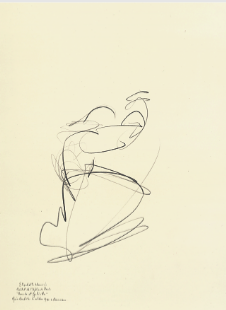
© Stanley Roseman
10. Elisabeth Maurin, 1995
Paris Opéra Ballet
Romeo and Juliet
Pencil on paper, 38 x 28 cm
Musée des Beaux-Arts, Bordeaux
Paris Opéra Ballet
Romeo and Juliet
Pencil on paper, 38 x 28 cm
Musée des Beaux-Arts, Bordeaux
"The Musée des Beaux-Arts of Bordeaux is very honored by the donation of three of your drawings: Kassya, 1995, Fanny Gaïda, 1996, and Elisabeth Maurin, 1995, that you have generously offered. They enrich the collection of 20th century drawings that are conserved in the museum and constitute with the series of the Monks and The Balcony by Jean Genet an ensemble of very great interest.''
- Francis Ribemont
Chief Curator of Patrimony
Musée des Beaux-Arts de Bordeaux
Chief Curator of Patrimony
Musée des Beaux-Arts de Bordeaux
Francis Ribemont, Chief Curator of Patrimony, Museum of Fine Arts, Bordeaux, acquired the artist's drawing of Elisabeth Maurin; a drawing of Paris Opéra star dancer Fanny Gaïda in La Bayadère, (Plate 80 in the book); and a drawing of Russian clown Kassya in Sur la Route de Sienne at the Théâtre le Ranelagh, Paris. In a cordial letter to Roseman, Francis Ribemont writes:
The Individuality of the Dancer
The Bibliothèque Nationale de France in its exhibition publication states: "One of the objectives of the exhibit is to emphasize the artist's intent, through several ballets and works of modern dance . . . to express the individuality of the dancer by showing drawings of different dancers executing the same role.'' The book Stanley Roseman and the Dance - Drawings from the Paris Opéra also presents such a selection of the artist's work, as exemplified by the superb drawings of two great star dancers Monique Loudières, seen at the top of the page, (Plate 4 in the book), and Elisabeth Maurin, (Plate 124 and fig. 10, below), as Juliet in Romeo and Juliet, choreographed by Rudolf Nureyev to Serge Prokofiev's symphonic score.
Monique Loudières, 1995, in the British Museum, London, depicts the star dancer at a climactic moment in the ballet. Roseman's vigorous pencil lines are charged with emotion expressing at once the outward kinetic movements of the dancer and the inner turmoil of Juliet as she thrashes with conflicting feelings of family loyalty to her cousin Tybalt, killed by Romeo in a duel, and her devotion to her beloved.
from Librarians
Bibliophiles
The Director and the Keeper of Prints and Drawings of the Teyler Museum, The Netherlands.
Roseman's drawings on the dance and the subject of the clown in the museum's collection
are reproduced in the book, (Plate 81 and fig. 3).
The Abbot of Solesmes
At the French Benedictine monastery, Roseman drew Two Monks Bowing, Abbaye de Solesmes,
1979, today in the collection of the National Gallery of Art, Washington, D.C. The drawing is
reproduced in the artist's introductory text in the book, (fig. 4).
A teacher of Stanley Roseman
Bibliophiles
The Director and the Keeper of Prints and Drawings of the Teyler Museum, The Netherlands.
Roseman's drawings on the dance and the subject of the clown in the museum's collection
are reproduced in the book, (Plate 81 and fig. 3).
The Abbot of Solesmes
At the French Benedictine monastery, Roseman drew Two Monks Bowing, Abbaye de Solesmes,
1979, today in the collection of the National Gallery of Art, Washington, D.C. The drawing is
reproduced in the artist's introductory text in the book, (fig. 4).
A teacher of Stanley Roseman
Art, Architecture & Photography - Entertainment / Dance
Music, Opera - Art, Architecture and Photography
Music, Opera - Entertainment / Dance
Music, Opera - Art, Architecture and Photography
Music, Opera - Entertainment / Dance
The Musée des Beaux-Arts, Bordeaux, conserves the present drawing of Elisabeth Maurin as Juliet. Alone on stage, the dancer was confronting the darkening events in Juliet's life when the artist, standing in the wings, created this compelling work imbued with pathos.
Roseman's nuanced, pencil lines - from threads of light gray to dark ribbon-like strokes - describe a desperate Juliet falling to her knees, her head bent low and covered by the voluminous material of her sleeve as she raises an arm into the air. Drawing the dance movements with a spiral leitmotif to the pencil lines, Roseman conveys the mental state of Juliet and her whirl of emotions.
The Musée d'Art Moderne et Contemporain, Strasbourg, conserves four of the artist's drawings on the dance which are reproduced in Stanley Roseman and the Dance - Drawings from the Paris Opéra. Presented here, (fig. 11), and in the book, (Plate 104), is the splendid drawing of Paris Opéra star dancer Elisabeth Platel. Roseman's swiftly flowing pencil lines capture on paper the virtuosa ballerina in a breathtaking leap in her variation from Balanchine's jubilant Tchaikovsky - Pas de Deux.
The Curator of Patrimony and Director of the Museums of Strasbourg Rodolphe Rapetti, later appointed Chief Curator of Patrimony and Deputy Director of the Museums of France; and the Curator of the Cabinet of Prints and Drawings of Strasbourg, Anny-Claire Haus, write in letter to Ronald Davis:
Stanley Roseman and the Dance - Drawings from the Paris Opéra includes four drawings in the Palais des Beaux-Arts, Lille, which contains a world-renowned collection of Master Drawings, notably from the Italian Renaissance, with works by Michelangelo, Fra Bartolommeo, and an outstanding group of drawings by Raphael, as well as works from the major French, Flemish, German, and Dutch schools.
Roseman delineates the dancer's head, uplifted arms, broad chest, and tapering abdomen ''with a few masterful strokes of a pencil'' (Associated Press, Paris). A single, continuous, undulating line defines the dancer's lower torso and muscular legs: the right leg, a pillar of support; the left leg thrust high into the air. In this dynamic composition Roseman has created an electrifying image of the male dancer.
''Please convey my congratulations to Monsieur Stanley Roseman for the great quality of his drawings. We are proud to incorporate the work in our collection."
The drawings of Monique Loudières and Elisabeth Maurin in their roles as Juliet in Romeo and Juliet are also presented on the website page "Biography,'' Page 2 - "Variety of Drawing Materials and the World of Shakespeare.''
The poster features Paris Opéra star dancer Charles Jude in his acclaimed role as Prince Siegfried in Nureyev's choreography of Tchaikovsky's celebrated Swan Lake. Jude writes in an eloquent testimony on Roseman's work: "This drawing of Stanley's marvelously reflects the poetry and the immateriality of movement. I am proud to be the inspiration of this work."
In his text "On Drawing and the Dance," Roseman brings the reader with him into the dance studios at the Paris Opéra and into the wings of that illustrious stage. The artist speaks about his choice of drawing materials and his preference for the pencil for his drawings on the dance. He writes eloquently about the line in art in a paragraph that begins: "Line is the essence of a drawing." Concluding his text Roseman writes: ''The rehearsal halls and the wings of the Paris Opéra were my studio, and many of the greatest dancers today were the subjects of my drawings. Even with the familiarity of repeated performances, I could not contain the excitement I felt each time I resumed my work. I was inspired by the music and the dance to draw.''
7. Yoshiaki Nagahata, 1993
Tokyo Ballet
"M"
Pencil on paper, 37.5 x 27.5 cm
Private collection, Switzerland
Tokyo Ballet
"M"
Pencil on paper, 37.5 x 27.5 cm
Private collection, Switzerland
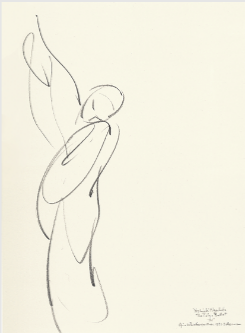
© Stanley Roseman
The Tokyo Ballet celebrated its 30th anniversary with a guest appearance at the Paris Opéra in November 1993. The Company presented Maurice Béjart's ballet entitled "M,'' a balletic evocation of the life of the Japanese author Mishima, with music by Toshiro Mayuzumi and additional extracts from Debussy, Satie, Johann Strauss, and Wagner.
From Roseman's excellent suite created at performances of the Tokyo Ballet is the beautiful drawing of Yoshiaki Nagahata, (fig. 7). With a striking mis-en-page and nuanced, curvilinear strokes of the graphite pencil, the artist depicts the voluminously robed dancer in a lyrical dance movement.